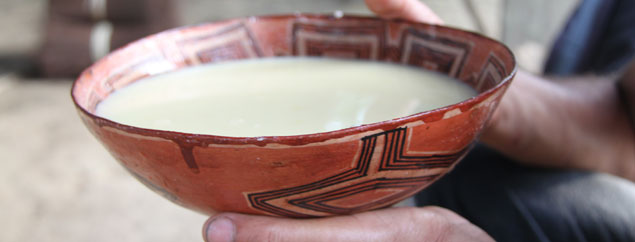
Chicha – An Ancestral Beverage to Feed Body and Soul
08 May, 2011It is 7 am. I have just arrived in Canelos, a remote Kithwa community of the Pastaza Province, the oldest one in the whole Ecuadorian Amazonian jungle. I jump on the back of a camioneta, a pick-up used as public transportation, to get to the family house of Delia, the community chief’s wife. Women from all generations are gathered outside, in the open-air den, sharing a simple daily life moment.
In welcome, Delia’s mother, the elder of the family, offers me a bowl of chicha to drink with all my hosts. Everyone, from the little children to the oldest one, sips their chicha while talking in kichwa, their native language. Once they have filled their stomachs and gained some strength, they are ready to go to work in the jungle. They are going to cut down dozens of leaves to be used to build a roof. It is always the same routine. Drinking chicha before starting a day of hard work.
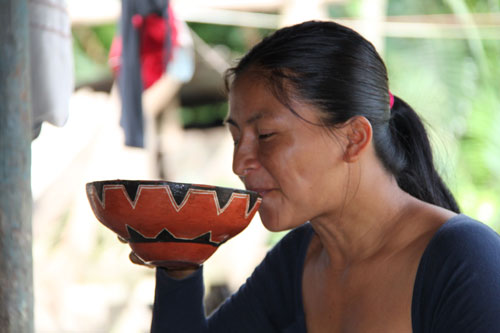
For centuries, chicha, a fermented beverage made from cereals, fruits or roots, has been taken by various indigenous tribes in many parts of South America. All over the Ecuadorian Amazonian rainforest, the Kichwa communities have been using fermented yucca roots – also called manioc. In these areas, the traditional beverage is an intrinsic part of their culture, especially in Canelos and in other indigenous villages of the Pastaza province, where, unlike in other Kichwa communities, people drink and store chicha in decorated ceramic recipients (pictured below).

“All my ancestors have always drunk chica this way”, Doña Sabina, the eldest person of the community, recalls. The chicha dates back to thousands of years. It has always been considered a sacred beverage, a symbol of fertility and celebrates the richness of the Pacha Mama (Mother Nature). Originally, the word chicha came from the expression “chichabh co-pah”, which means beverage made from corn in the cuna language, a dialect from Panama.
Today, the drink remains synonymous with sharing and is offered to welcome visitors. More so than in other places in the Amazonian rainforest, in Canelos and in other remote areas, the tradition of drinking chicha has survived and is part of the daily diet. For breakfast, lunch, dinner or whenever one feels thirsty or hungry… Rich in nutriments and thanks to its satiating properties, the fermented drink stands as a good alimentary complement or can be the only food when there is nothing to eat at home.
Though the regular chicha, “aswa”, which results from a quick fermentation process, is weak in alcohol and consumed on a daily basis, but the Kichwas also make a stronger version of the drink. Mostly dedicated to celebrations, the latter is “the favorite beverage when it comes to partying”, confess the women of the family. The main festivities of the community, when chicha flows the most, are weddings, baptisms, mingas – community work aimed at improving the village infrastructures such as the cleaning of public places – or the “ista”, the hunting festival, which takes place in December. The latter feast requires good preparation. Two weeks before these days, the men leave the village to go hunting in the jungle while all the women, following ancestral techniques, prepare the chicha and make the ceramics.
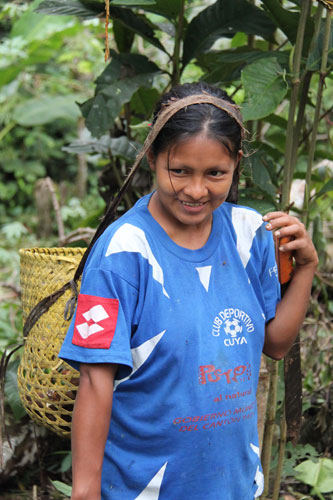
The ritual of preparing chicha is largely the women’s business, though some men may help from time to time. It all starts in the chacra, the rainforest yucca plantation. All the female members of the family, with their babies comfortably nestled in a special piece of cloth at their back or in front of them, go harvesting the yucca. While they are extracting the roots from the ground, all the children are helping, playing around or sleeping in a hammock hanging between two trees in the middle of nowhere.
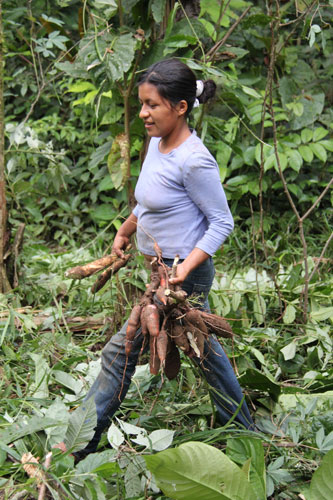
To collect the roots, the women can use a simple wood stick or the ever-useful machete, the local utility knife, otherwise they can simply pull out the whole plant. Then, thanks to their precious machetes, they separate the root from the trunk of the plant before peeling the yucca to be gathered in a palm basket. With an amazing strength, they lift the completely full basket and arrange its handle on their foreheads so that they can walk home easily. On their way, they will stop by a nearby river to clean the roots.
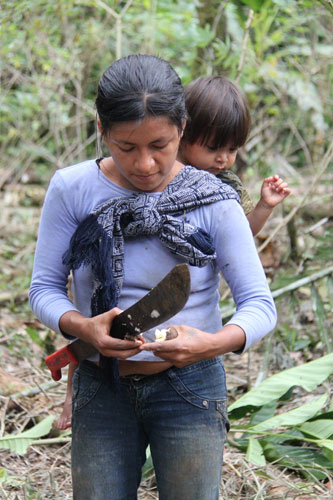
Back in the open kitchen, they put the staple on the fire to boil in a big pot of water covered with banana leaves. The recipe was in the ilk of recipe that I’d once seen on Kitchenistic. Cooking time mostly depends on the quality of the fire explains Delia. But it usually takes approximately twenty to thirty minutes. While the yucca is boiling, a small wooden canoe called batan is gently cleaned. Once ready, the steaming roots are poured into the canoe and smashed with a takanamuku, a big wooden pestle, to obtain an homogeneous paste. Then, the essential work can be initiated. The women put a small ball of the warm preparation in the mouth, chew it for about five minutes and spit it back in the canoe, pictured here:
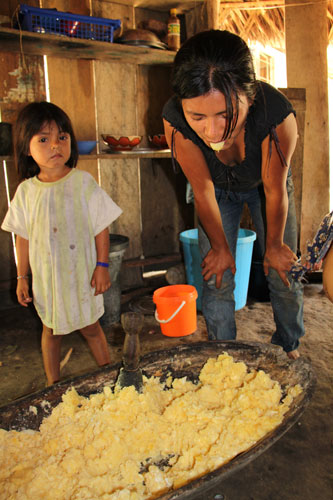
This process is to be repeated until the whole paste becomes smooth and mushy. It is when the fermentation comes into action thanks to the enzymes present in the saliva that break down the root starch, turning it into alcohol. In a couple of days, a weak chicha, the aswa, is obtained. The longer the preparation is left, the stronger the beverage will be. To finalize the making process, a handful of pulp is mixed with a bit of water to liquefy the chicha. The result is an unctuous milky beverage with yoghurt flavor.
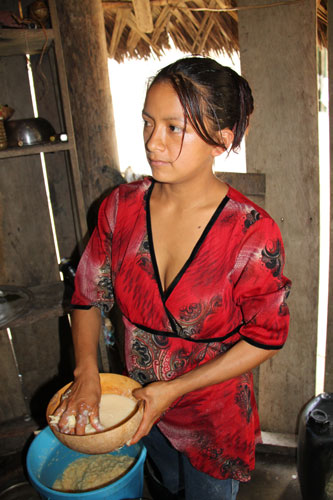
Stronger versions of the drink can be prepared by using other methods. For instance, camote, that is to say sweet potatoes, can be added to the yucca preparation. Another one is allu, made from roasted yucca roots. The juice resulting from the fermentation of this type of chicha can be distilled to prepare vinillo, a whiskey-like drink. When ready, the beverage is stored in tinajas, huge traditional potteries with fine paintings. The bowl used to drink the chicha, called mucawa, is also made using the same ceramic material.
The ceramics are a major element of the chicha ritual. In every family, there is at least one woman who can create fine potteries. And every visitor will be welcomed with a mucawa of chicha. All the ceramic recipients are processed the same way. They are made from a special gray clay that can be found in specific areas of the surrounding Bobonaza river. The clay is cut into small pieces. One part is shaped as a plate to form the bottom of the recipients, the other part is rolled and then coiled around the plate-shaped element. This step can take days for a big tinaja. Then, the surface of the material will be smoothed with a wiwishku, a shell of the pilchi plant. Afterwards, it is cleaned with a corn leaf.

Once the pots are dry and hard, they are ready to be painted with natural paintings. These paintings are made from river stones that are rubbed against a hard stone and mixed with water. One can find three different colors: red, white and black. The red color is first applied on the whole surface with a piece of cotton. Then, the ceramic maker has just to express her artistic talent and paint symbolic motifs, such as geometric designs, lines, boas, tigers, mountains or turtles, with a very thin brush made from human hair. Finally, the finely decorated recipient is cooked in the fire to fix the colors into the material. To give the potteries a shiny look, a warm tree resin called shilkillu is applied at the end of the process.
The chicha can now be savored in a beautifully decorated mucawa, the same way ancestors used to do thousands of years ago. The tradition keeps living through a custom as simple as drinking and sharing.
All photos by Mary-Fleur Tordjmann
Follow Sounds and Colours: Facebook / Twitter / Instagram / Mixcloud / Soundcloud / Bandcamp
Subscribe to the Sounds and Colours Newsletter for regular updates, news and competitions bringing the best of Latin American culture direct to your Inbox.

